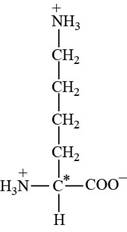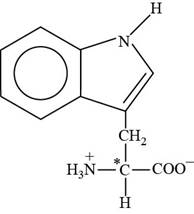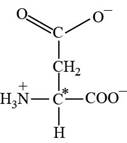
Concept explainers
a.
To draw:
The structure of alanine and mark an asterisk (*) next to any chiral carbon centers.
Introduction:
Amino acids contain a protonated
a.
Explanation of Solution
Alanine is a non essential amino acid. The three letter abbreviation of alanine is “Ala” and the one letter code is “A”. The side chain of alanine contains hydrocarbon as functional group.
Pictorial representation:
The structure of amino acid Alanine.

Fig 1: The structure of amino acid Alanine (Ala, A).
b.
To determine:
The structure of lysine and mark an asterisk (*) next to any chiral carbon centers
Introduction:
Amino acids contain a protonated amine and a carboxylic acid in the form of carboxylate ion. These two functional groups are bonded to a central carbon atom called the alpha-carbon. The protonated amine bonded to this carbon is called alpha-amino group and the carboxylate ion as the alpha carboxylate group. The alpha-carbon is also bonded to a hydrogen atom and a large side chain designated as R, which gives unique identification and characteristics to each amino acids.
b.
Explanation of Solution
Lysine is an essential amino acid. The three letter abbreviation of lysine is “Lys” and the one letter code is “K”. The side chain of lysine contains protonated amine as functional group.
Pictorial representation: The structure of amino acid Lysine.

Fig 2: The structure of amino acid Lysine (Lys, K).
c.
To determine:
The structure of tryptophan and mark an asterisk (*) next to any chiral carbon centers
Introduction:
Amino acids contain a protonated amine and a carboxylic acid in the form of carboxylate ion. These two functional groups are bonded to a central carbon atom called the alpha-carbon. The protonated amine bonded to this carbon is called alpha-amino group and the carboxylate ion as the alpha carboxylate group. The alpha-carbon is also bonded to a hydrogen atom and a large side chain designated as R, which gives unique identification and characteristics to each amino acids.
c.
Explanation of Solution
Tryptophan is an essential amino acid. The three letter abbreviation of tryptophan is “Trp” and the one letter code is “W”. The side chain of tryptophan contains
Pictorial representation:
The structure of amino acid Tryptophan.

Fig 3: The structure of amino acid Tryptophan (Trp, W).
d.
To determine:
The structure of aspartate and mark an asterisk (*) next to any chiral carbon centers
Introduction:
Amino acids contain a protonated amine and a carboxylic acid in the form of carboxylate ion. These two functional groups are bonded to a central carbon atom called the alpha-carbon. The protonated amine bonded to this carbon is called alpha-amino group and the carboxylate ion as the alpha carboxylate group. The alpha-carbon is also bonded to a hydrogen atom and a large side chain designated as R, which gives unique identification and characteristics to each amino acids.
d.
Explanation of Solution
Aspartate is a non essential amino acid. The three letter abbreviation of aspartate is “Asp” and the one letter code is “D”. The side chain of aspartate contains carboxylate as functional group.
Pictorial representation:
The structure of amino acid Aspartate.

Fig 4: The structure of amino acid Aspartate (Asp, D)
Want to see more full solutions like this?
Chapter 10 Solutions
EBK LABORATORY MANUAL FOR GENERAL, ORGA
- Draw the Lewis structure for the polyatomic phosphite (PO¾³¯) a anion. Be sure to include all resonance structures that satisfy the octet rule. C I A [ ]¯arrow_forwardDecide whether these proposed Lewis structures are reasonable. proposed Lewis structure Is the proposed Lewis structure reasonable? Yes. :0: Cl C C1: 0=0: : 0 : : 0 : H C N No, it has the wrong number of valence electrons. The correct number is: ☐ No, it has the right number of valence electrons but doesn't satisfy the octet rule. The symbols of the problem atoms are:* ☐ Yes. No, it has the wrong number of valence electrons. The correct number is: ☐ No, it has the right number of valence electrons but doesn't satisfy the octet rule. The symbols of the problem atoms are:* Yes. ☐ No, it has the wrong number of valence electrons. The correct number is: ☐ No, it has the right number of valence electrons but doesn't satisfy the octet rule. The symbols of the problem atoms are:* | * If two or more atoms of the same element don't satisfy the octet rule, just enter the chemical symbol as many times as necessary. For example, if two oxygen atoms don't satisfy the octet rule, enter "0,0".arrow_forwardDraw the Lewis structure for the polyatomic trisulfide anion. Be sure to include all resonance structures that satisfy the octet rule. с [ ] - Garrow_forward
- 1. Calculate the accurate monoisotopic mass (using all 1H, 12C, 14N, 160 and 35CI) for your product using the table in your lab manual. Don't include the Cl, since you should only have [M+H]*. Compare this to the value you see on the LC-MS printout. How much different are they? 2. There are four isotopic peaks for the [M+H]* ion at m/z 240, 241, 242 and 243. For one point of extra credit, explain what each of these is and why they are present. 3. There is a fragment ion at m/z 184. For one point of extra credit, identify this fragment and confirm by calculating the accurate monoisotopic mass. 4. The UV spectrum is also at the bottom of your printout. For one point of extra credit, look up the UV spectrum of bupropion on Google Images and compare to your spectrum. Do they match? Cite your source. 5. For most of you, there will be a second chromatographic peak whose m/z is 74 (to a round number). For one point of extra credit, see if you can identify this molecule as well and confirm by…arrow_forwardPlease draw, not just describe!arrow_forwardcan you draw each step on a piece of a paper please this is very confusing to mearrow_forward
- > Can the molecule on the right-hand side of this organic reaction be made in good yield from no more than two reactants, in one step, by moderately heating the reactants? esc ? A O O •If your answer is yes, then draw the reactant or reactants in the drawing area below. You can draw the reactants in any arrangement you like. • If your answer is no, check the box under the drawing area instead. olo 18 Ar Explanation Check BB Click and drag to start drawing a structure. 2025 McGraw Hill LLC. All Rights Reserved. Terms of Use | Privacy Center Accessibilityarrow_forwardName the structurearrow_forward> For each pair of substrates below, choose the one that will react faster in a substitution reaction, assuming that: 1. the rate of substitution doesn't depend on nucleophile concentration and 2. the products are a roughly 50/50 mixture of enantiomers. Substrate A Substrate B Faster Rate X CI (Choose one) (Choose one) CI Br Explanation Check Br (Choose one) C 2025 McGraw Hill LLC. All Rights Reserved. Terms of Use | Privacy A F10arrow_forward
- How to draw this mechanism for the foloowing reaction in the foto. thank youarrow_forwardPredict the major products of the following organic reaction: Some important notes: CN A? • Draw the major product, or products, of the reaction in the drawing area below. • If there aren't any products, because no reaction will take place, check the box below the drawing area instead. • Be sure to use wedge and dash bonds when necessary, for example to distinguish between major products that are enantiomers. No reaction. Explanation Check Click and drag to start drawing a structure. 2025 McGraw Hill LLC. All Rights Reserved. Terms of Use Privacy Centerarrow_forwardDraw the major product of the following reaction. Do not draw inorganic byproducts. H3PO4 OHarrow_forward
 Chemistry for Today: General, Organic, and Bioche...ChemistryISBN:9781305960060Author:Spencer L. Seager, Michael R. Slabaugh, Maren S. HansenPublisher:Cengage LearningChemistry: Matter and ChangeChemistryISBN:9780078746376Author:Dinah Zike, Laurel Dingrando, Nicholas Hainen, Cheryl WistromPublisher:Glencoe/McGraw-Hill School Pub Co
Chemistry for Today: General, Organic, and Bioche...ChemistryISBN:9781305960060Author:Spencer L. Seager, Michael R. Slabaugh, Maren S. HansenPublisher:Cengage LearningChemistry: Matter and ChangeChemistryISBN:9780078746376Author:Dinah Zike, Laurel Dingrando, Nicholas Hainen, Cheryl WistromPublisher:Glencoe/McGraw-Hill School Pub Co Chemistry: Principles and ReactionsChemistryISBN:9781305079373Author:William L. Masterton, Cecile N. HurleyPublisher:Cengage Learning
Chemistry: Principles and ReactionsChemistryISBN:9781305079373Author:William L. Masterton, Cecile N. HurleyPublisher:Cengage Learning ChemistryChemistryISBN:9781305957404Author:Steven S. Zumdahl, Susan A. Zumdahl, Donald J. DeCostePublisher:Cengage Learning
ChemistryChemistryISBN:9781305957404Author:Steven S. Zumdahl, Susan A. Zumdahl, Donald J. DeCostePublisher:Cengage Learning Chemistry: An Atoms First ApproachChemistryISBN:9781305079243Author:Steven S. Zumdahl, Susan A. ZumdahlPublisher:Cengage Learning
Chemistry: An Atoms First ApproachChemistryISBN:9781305079243Author:Steven S. Zumdahl, Susan A. ZumdahlPublisher:Cengage Learning





